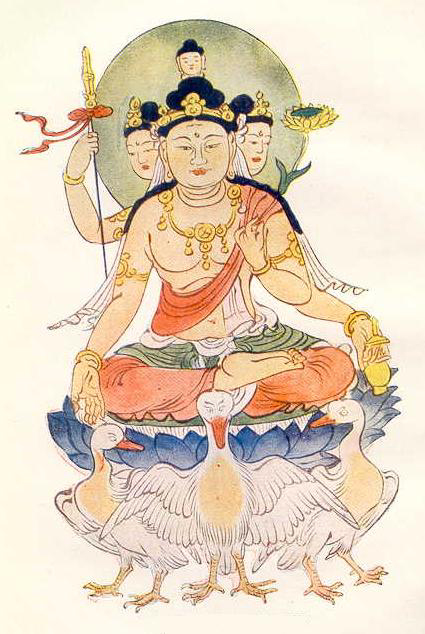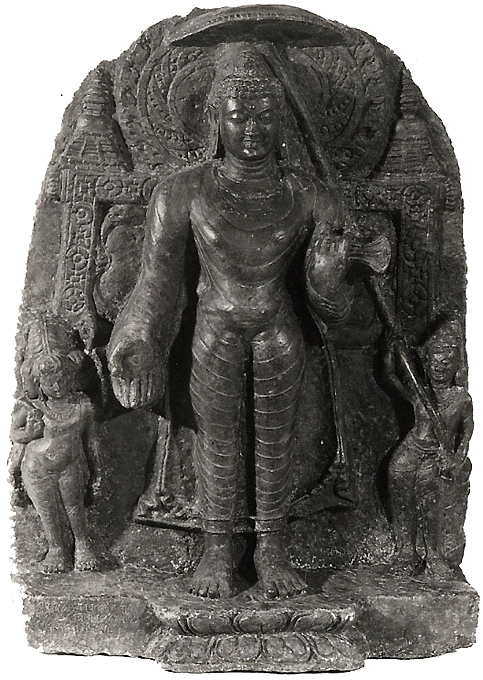
|
|
|
|
In a previous segment we introduced the topic of Lord Brahma's influence on Buddhism in the context of South Indian temple worship, as we visited the Kadri Manjunath Temple near Mangalore. The presiding deity, Lord Brahma, is worshipped there by Vaisnava, Saivite, and Buddhist names. We briefly mentioned in that article the prevalence of Brahma worship in Thailand and Nepal, but this only touched the surface of the subject. As we will see in this and the segments to following, there are many correspondences between Brahmadeva and Buddhist traditions, some involving Visnu, other involving Indra. These pastimes are woven into themes of worship in both the Vaisnava and Buddhist schools. We also mentioned in a previous segment that there is some historical evidence to suggest that Bodhidharma, the sadhu who founded the Zen school of Buddhism in China, was a prince of the Pallava dynasty in India. While Lord Brahma's influence spread throughout China, we don't know to what degree the Pallava influence, which minimized Brahmadeva's worship in India, also traveled and offset Brahmadeva's presence as it was associated with Buddha in China. The narration to follow sheds some light in that direction.

Lord Brahma (right) and Indra (left) Ancient Chinese painting In his most recent incarnation, the place of Lord Buddha's appearance was Gaya, Bihar, about 250 km. south of Nepal. It's common knowledge that the Buddha's influence was strongly established in Nepal, and eventually throughout China, but what is less well known is the strong association that developed between Buddha, Lord Brahma, and Indra, together. Particularly in northeast India, Nepal, and China, the many deity forms and painted images of Brahma, Indra and Buddha attest to the popularity of this divine triad. It appears that the primary sastric pastime in which Lord Brahma was associated with Buddha and Indra was that of Buddha, Brahma and Devraj Indra descending together at a place called Sankisa. Also known as Basantpur, the village of Sankisa is situated on the banks of the River Kali. Sankisa is 47 km. away from Fatehgarh, in the Farrukhabad district of Uttar Pradesh. Buddha, Brahma and Indra are said to have manifested here after preaching to Buddha's mother, Maya, in the heavenly planets. There is a temple erected at Sankisa in which a murti of Buddha is installed, along with a beautiful Ashokan elephant pillar and a large Shiva lingam. Buddha is said to have descended with Brahma and Indra after preaching the Dhamma (Abhidhamma) to his mother and other demigods at Tusita (Tushita). The Mauryan Emperor Ashoka erected the elephant pillar here to mark this holy spot. According to monks at the Myanmar Buddhist Vihara (monastery), before each incarnation of the Buddha, there are four places (avizahira), always determined in advance, where the Buddha will perform certain pastimes. In the case of Gotama Buddha, these places were: Bodh Gaya, where He attained liberation, Migadawon, where He began to preach, Sravasti, where He expounded the law and refuted heretics, and Sankisa, where He descended from the Tushita Heaven after having preached to His mothers (Sankisa).

Lord Brahma on Hamsa Chinese painting In a description given by the Myanmar monks, we learn the details of the scene of Brahma, Indra and Buddha's descent at Sankisa. This pastime is referred to as the event of 'the great ladder', by which the triad descended. There is an image of this pastime in a stone sculpture at Bharhut, c. 100 B.C. The ladder represents a triple flight of solid stone steps that were created by Devraj Indra (Sakka). One ladder was built of gold, one of precious jewels, and one of silver. All were decorated with seven precious stones. The tops of the ladders rested on the summit of Mount Meru, and the feet of the ladders were set down against the main gate of the City of Sankisa. Gotama Buddha descended down the ruby-jeweled ladder in the center. On His left side, Lord Brahma and his train (procession) descended down the silver ladder, holding the Buddha's umbrella. Sakka (Indra) and the devas descended on the right side, down the golden ladder, with Indra carrying Buddha's alms bowl.

Descent of Lord Buddha, Brahma and Indra Schist sculpture, c. 800 A.D. While the stone image at Bharhut depicting the descent of Buddha, Brahma and Indra down their ladders is dated circa 100 B.C., historical references are found which suggest that Buddhism was only introduced into China around 65 A.D., and from there it traveled south to Java, and east to Korea and Japan. While there is much debate as to the dates of Gotama Buddha's appearance and disappearance, it is generally agreed to have been around 400 B.C. That would place the Barhut sculpture at 300 years after His departure, and the introduction of Buddhism into China another 165 years later. If these dates were correct, it would place Lord Brahma's appearance with Indra and Buddha at approximately 3,000 years ago – 2,000 years after the battle of Kurukshetra. To our knowledge, this would be the most recent recorded appearance of Lord Brahma on the earth planet. This date becomes particularly interesting when considered in the context of the founding of our Brahma Sampradaya. In a previous segment on the Brahma temple at Lingampally, Andhra Pradesh, we shared an interesting description of the origination of our Sampradaya, as narrated by the devotees at Sri Madhvacaraya's Shri Uttaradi Matha in Lingampally. How Lord Brahma's appearance in Sankisa fits into the timeline of disciplic succession represented in Srila Prabhupada's 'List of 32' Sampradaya Acaryas is beyond our conception. How many manifestations of Brahmas have come and gone, and who exactly the Brahma was that descended the ladder in Sankisa, we do not know, but reading about the pastime certainly increases our appreciation and affection for the founding father of our Sampradaya.
| |

